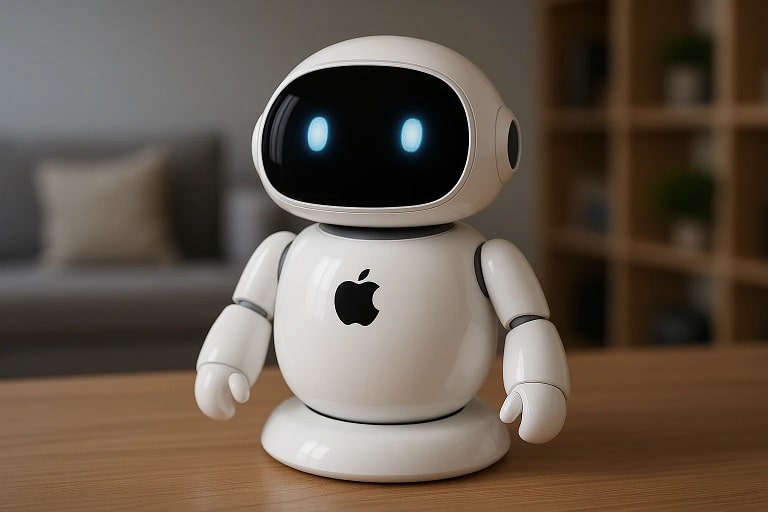Cupertino, August 15, 2025 – Apple Inc. is set to redefine its position in the artificial intelligence (AI) landscape with an ambitious lineup of smart home devices, headlined by a tabletop robot slated for a 2027 launch. Valued at over $3 trillion, Apple aims to rebound from criticism of lagging in generative AI by introducing a robotic companion with a lifelike Siri, a smart display, and AI-powered home security cameras. This strategic pivot, led by former Apple Watch software chief Kevin Lynch, seeks to integrate advanced AI into daily life, positioning Apple to compete with rivals like Samsung, Meta, and OpenAI in the rapidly evolving smart home market.
A Tabletop Robot to Lead the Charge
At the heart of Apple’s AI strategy is the tabletop robot, codenamed J595, featuring a 7-inch iPad-like display mounted on a motorized arm capable of rotating and extending six inches in any direction. Described internally as the “Pixar Lamp” for its resemblance to the animated studio’s iconic mascot, the robot is designed to act as a virtual companion, tracking users, joining conversations, and offering suggestions like nearby restaurants or travel plans. Powered by a revamped Siri with large language model (LLM) capabilities, codenamed Linwood or Glenwood, the robot will feature a visual personality, potentially resembling an animated Finder logo or Memoji.
The device, targeted for a 2027 release, supports FaceTime with a Center Stage-like feature for dynamic video calls and may include joystick control via iPhone for precise positioning. Bloomberg reports suggest it will run on a new multiuser operating system, Charismatic, designed for personalized interactions and home automation.
Device | Codename | Key Features | Launch Timeline |
|---|---|---|---|
Tabletop Robot | J595 | 7-inch display, motorized arm, LLM Siri, FaceTime support | 2027 |
Smart Display | J490 | Music playback, note-taking, video calls, Charismatic OS | Mid-2026 |
Security Cameras | J450 | Facial recognition, infrared sensors, home automation | TBD |
Broader AI Ecosystem: Smart Displays and Security
Apple’s comeback plan extends beyond the robot. A smart display (J490), a simplified version without the robotic arm, is slated for mid-2026. Running on the Charismatic OS, it will support music playback, note-taking, web browsing, and video conferencing, competing with Amazon’s Echo Show and Google Nest Hub. Additionally, Apple is developing battery-powered security cameras (J450) with facial recognition and infrared sensors to automate household tasks, such as lighting or media playback, integrating with a broader Apple security system.
These devices aim to make Apple’s ecosystem stickier, leveraging an upgraded Siri to lock users into its services. The company is also exploring a mobile robot with wheels and a mechanical arm for industrial use, though this remains a longer-term project.
Component | Function | Technology | Impact |
|---|---|---|---|
Siri (Linwood/Glenwood) | Conversational AI | Large language models, visual personality | Enhanced user interaction, task automation |
Charismatic OS | Multiuser platform | Face-scanning, personalized layouts | Seamless smart home integration |
Robotic Arm | User tracking | Servo control, real-time localization | Dynamic, person-like engagement |
Strategic Context: Reclaiming AI Leadership
Apple’s push comes after criticism for missing the generative AI revolution, with competitors like OpenAI and Meta advancing rapidly. The Vision Pro headset’s lackluster sales and static device designs have fueled perceptions of Apple’s innovation lag. CEO Tim Cook, in a July 2025 all-hands meeting, declared that Apple “must win in AI,” describing the product pipeline as “amazing.” The tabletop robot, led by Lynch, builds on Apple’s prior robotics research, including the canceled Apple Car project and earlier humanoid robot concepts like “Armor.”
India’s emergence as the top U.S. smartphone supplier in Q2 2025, driven by Apple’s supply chain shift, provides a favorable backdrop. However, U.S. tariffs, including a 25% duty on Indian imports, and Trump’s call to curb Indian tech hiring could complicate Apple’s global operations. Posts on X reflect enthusiasm, with @LogicalBadger noting the robot’s potential to “revolutionize personal AI interactions,” while @SiliconANGLE highlighted its 2027 timeline.
Challenges and Market Dynamics
The tabletop robot faces significant hurdles. The unproven home robot market, as noted by former CNET editor Lisa Eadicicco, poses adoption risks, with consumers questioning the need for such devices. Technical challenges include precise servo control, mechanical reliability, and integrating generative AI without compromising Apple’s privacy standards. The project’s success hinges on Apple Intelligence’s progress, with the LLM-powered Siri delayed until after 2026.
Apple’s $3.3 trillion market cap provides financial muscle, but competition from Amazon’s Astro, Tesla’s robotics efforts, and startups like 1X Technologies could challenge its dominance. The company’s history of shelving ambitious projects, like the Apple Car, adds execution risk.
Future Outlook
Apple aims to redefine the smart home by 2027, with the tabletop robot as its centerpiece. The smart display’s 2026 launch will test market appetite, while advancements in Siri and Charismatic OS could set new standards for AI-driven home devices. As India strengthens its role in Apple’s supply chain and global tech ecosystem, the company must navigate trade tensions and geopolitical complexities to maintain its edge.
Conclusion: A Bold Leap into AI-Driven Homes
Apple’s tabletop robot, set for 2027, marks a daring bid to reclaim AI leadership and transform the smart home landscape. By blending robotics, a lifelike Siri, and a new OS, Apple aims to create a seamless, person-like AI experience. As it competes with global rivals and leverages India’s manufacturing prowess, Apple’s success will depend on overcoming technical and market challenges, potentially redefining how technology integrates into daily life.












